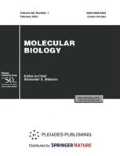Abstract
The dynamics and the level of accumulation of small heat shock proteins (sHSP group 21–27) after a heat exposure were studied in three Drosophila species differing in thermotolerance. The southern species Drosophila virilis, having the highest thermotolerance, surpassed thermosensitive D. lummei and D. melanogaster in the level of sHSPs throughout the temperature range tested. The results suggest an important role of sHSPs in the molecular mechanisms of adaptation to adverse environmental conditions, particularly to hyperthermia.
Similar content being viewed by others
References
Hunt C., Morimoto R.I. 1985. Conserved features of eukaryotic hsp70 genes revealed by comparison with the nucleotide sequence of human hsp70. Proc. Natl. Acad. Sci. USA. 82, 6455–6459.
Margulis B.A., Guzhova I.V. 2000. Stress proteins in eukaryotic cells. Tsitologiya. 42, 323–342.
Ul’masov Kh.A., Karryeva B.Ch., Karaev K. 1993. Stressovye belki i adaptatsiya (Stress Proteins and Adaptation). Ashkhabad: Ylym.
Haslbeck M., Walke S., Stormer T., Ernsperger M., White H.E., Chen S., Saibil H.R., Buchner J. 1999. HSP27: A temperature-regulated chaperone. EMBO J. 18, 6744–6751.
Kelley W.L. 1998. The J-domain family and the recruitment of chaperone power. Trends Biochem. Sci. 23, 222–227.
Krebs R.A. 1999. A comparison of Hsp70 expression and thermotolerance in adults and larvae of three Drosophila species. Cell Stress Chaperones. 4, 243–249.
Zatsepina O.G., Velikodvorskaia V.V., Molodtsov V.B., Garbuz D.G., Lerman D.N., Bettencourt B.R., Feder M.E., Evgenev M.B. 2001. A Drosophila melanogaster strain from sub-equatorial Africa has exceptional thermotolerance but decreased Hsp70 expression. J. Exp. Biol. 204, 1869–1881.
Garbuz D.G., Moloftsov V.B., Velikodvorskaia V.V., Zatsepina O.G., Evgenev M.B. 2002. Evolution of response to heat shock within the genus Drosophila. Genetika. 38, 1097–1109.
Garbuz D.G., Zatsepina O.G., Feder M.E., Evgen’ev M.B. 2003. Evolution of termotolerance and the heat-shock response: evidence from inter/intraspecific comparison and interspecific hybridization in the Drosophila virilis species group: 1. Thermal phenotype. J. Exp. Biol. 206, 2399–2408.
Mosser D.D., Caron A.W., Bourged L., Denis-Larose C., Massie B. 1997. Role of the human heat shock protein HSP70 in protection against stress-induced apoptosis. Mol. Cell Biol. 17, 5317–5327.
Evgenev M.B., Zatsepina O.G., Garbuz D.G., Lerman D.N., Velikodvorskaia V.V., Zelentsova E.S., Feder M.E. 2004. Evolution and arrangement of the hsp70 gene cluster in two closely related species of the virilis group of Drosophila. Chromosoma. 113, 223–232.
Chen Q., Ma E., Behar K.L., Xu T., Haddad G.G. 2002. Role of trehalose phosphate synthase in anoxia tolerance and development in Drosophila melanogaster. J. Biol. Chem. 277, 3274–3279.
Ayme A., Tissieres A. 1985. Locus 67B of Drosophila melanogaster contains seven, not four, closely related heat shock genes. EMBO J. 4, 2949–2954.
Laemmli U.K. 1970. Cleavage of structural proteins during the assembly of the head of bacteriophage T4. Nature. 227, 680–685.
O’Farrell P.H. 1975. High resolution two-dimensional electrophoresis of proteins. J. Biol. Chem. 250, 4007–4021.
Krebs R.A., Feder M.E. 1997. Deleterious consequences of HSP70 overexpression in Drosophila melanogaster larvae. Cell Stress Chaperones. 2, 60–71.
Feder M.E., Hofmann G.E. 1999. Heat-shock proteins, molecular chaperones, and the stress response: Evolutionary and ecological physiology. Annu. Rev. Physiol. 61, 243–282.
Evgenev M.B., Sheinker V.Sh., Levin A.V. 1987. Molecular mechanisms of adaptation to hyperthermia in higher organisms: 1. Heat shock protein synthesis in cultured cells and larvae of different silkworm species. Mol. Biol. 21, 484–494.
Mehlen P., Schulze-Osthoff K., Arrigo A.P. 1996. Small stress proteins as novel regulators of apoptosis. J. Biol. Chem. 271, 16510–16514.
Author information
Authors and Affiliations
Additional information
Original Russian Text © V.Yu. Shilova, D.G. Garbuz, M.B. Evgen’ev, O.G. Zatsepina, 2006, published in Molekulyarnaya Biologiya, 2006, Vol. 40, No. 2, pp. 271–276.
Rights and permissions
About this article
Cite this article
Shilova, V.Y., Garbuz, D.G., Evgen’ev, M.B. et al. Small heat shock proteins and adaptation of various Drosophila species to hyperthermia. Mol Biol 40, 235–239 (2006). https://doi.org/10.1134/S0026893306020087
Received:
Issue Date:
DOI: https://doi.org/10.1134/S0026893306020087




